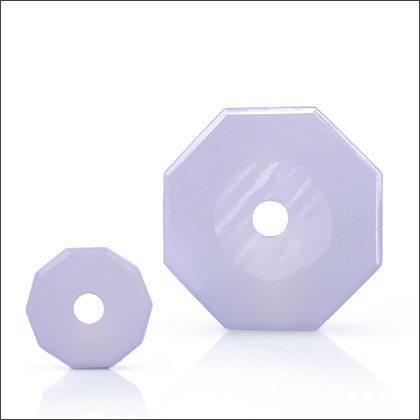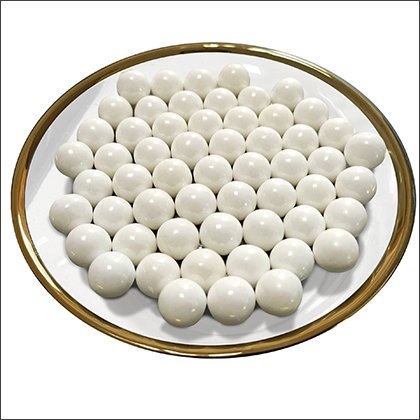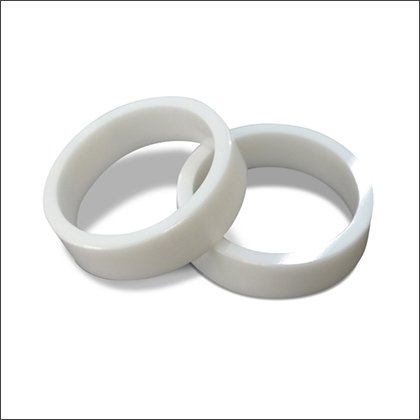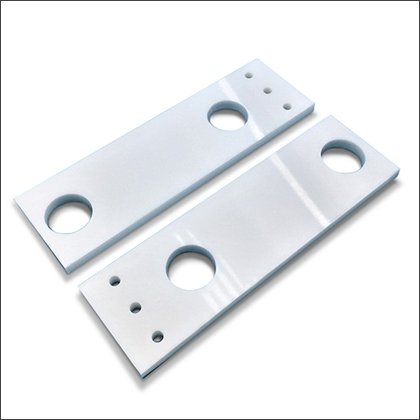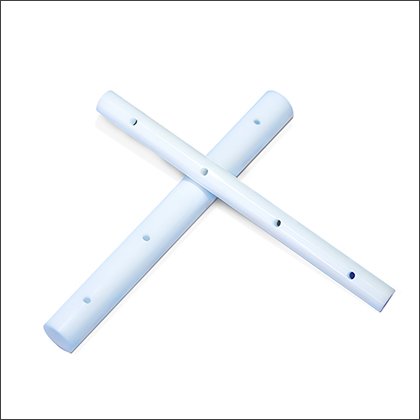Material Overview
Zirconia (ZrO₂) is a versatile advanced ceramic known for its exceptional mechanical strength, fracture toughness, and biocompatibility. Stabilized with oxides like yttrium oxide, calcium oxide, and magnesium oxide, it exists in multiple phases (monoclinic, tetragonal, cubic), enabling applications in aerospace, medical implants, industrial machinery, and dental prosthetics. Among them, yttria partially stabilized zirconia (YSZ) and magnesium oxide partially stabilized zirconia (MSZ) are the most common. With a unique phase transformation toughening mechanism that enhances crack resistance, zirconia ceramic is also called “ceramic steel” for high-stress environments application.
Technical Specifications
| Property | YSZ | MSZ |
| Density | 6.0 g/cm³ | 5.72 g/cm³ |
| Flexural Strength | 800 MPa | 750 MPa |
| Modulus of Elasticity (GPa) | 200 | 200 |
| Thermal Conductivity (W/m·K) | 3 | 2.2 |
| Max. service temperature (℃) | 1500 | 1500 |
| Dielectric Strength (kV/mm) | 9 | 9.4 |
Zirconia can be processed relatively easily into complex geometries in the green state. Once fully sintered, it needs to be machined/ground using diamond tools. The product forms of zirconia ceramics are mainly zirconia substrates, zirconia plates, zirconia tubes and zirconia structural parts. The following products show some of their uses in more product forms.
Key Features
- Ultra-High Strength: Flexural strength up to 800 MPa, surpassing alumina and lithium disilicate.
- Thermal Stability: Operates continuously at 1,500°C (air) and 2,500°C (inert atmospheres).
- Wear Resistance: Vickers hardness of 1,070–1,230 HV, ideal for abrasive environments like mining pumps.
- Biocompatibility: FDA-approved for dental crowns and hip implants, with minimal bacterial adhesion.
Applications
- High-stress mechanical parts: Replace metal in non-lubricated, high-temperature, or corrosive media (such as chemical pumps) to reduce friction and failure risks.
- High temperature/corrosive environment: Maintain stability in strong acid, strong alkali, or high-temperature gas to extend the life of the equipment.
- Electrochemical devices: Used in solid oxide fuel cells (SOFC), oxygen sensors, etc.
Hardness performance:
The Mohs hardness of zirconia ceramics is about 8.5-9, which is close to alumina ceramics (9) and much higher than ordinary steel (5-6). Its high hardness makes it scratch- and wear-resistant, making it suitable for high-wear applications such as cutting tools and bearings.
Cracking resistance:
Thanks to the phase transformation toughening mechanism, the fracture toughness of zirconia (6.5-11 MPa·m¹/²) is 2 times that of alumina ceramics (4-5 MPa·m¹/²), and it is not easy to break.
We support customization to meet diverse needs:
1. Size customization – Precision machining: After sintering, it can be processed into complex shapes through CNC, grinding, laser cutting, and other processes, with a tolerance of up to ±0.01mm.
2. Surface treatment – Polishing: Mirror polishing (Ra 0.1μm) is used for optical components or sealing surfaces.
- Pharmaceuticals: Zirconia plunger pumps resist acids (e.g., HCl) and alkalis, ensuring zero drug contamination during liquid filling.
- Energy: Solid oxide fuel cells use cubic zirconia electrolytes for oxygen ion conduction at 800°C.
- Semiconductors: Zirconia crucibles handle molten silicon without reactivity, critical for wafer production.
Beyond its renowned toughness and biocompatibility, Zirconia (ZrO2) ceramic is a versatile engineering solution pushing the boundaries of performance across sectors. The potential uses are vast, but they converge on one goal: solving complex engineering problems.
1. Electronics & Semiconductors: In insulating substrates, sensor components, and wafer processing parts, thanks to its excellent dielectric properties.
2. Industrial Automation: As pump seals, ball valves, and cutting tools that withstand extreme abrasion and corrosion.
3. Medical & Dental: From wear-resistant hip joint bearings and dental implants that promote osseointegration.
4. Automotive: For oxygen sensors, engine components, and wear parts that perform under high temperatures.
5. Consumer Goods: Enabling durability in precision knives, watch cases, and sporting goods.
Besides, zirconia ceramic has a diversity of potential uses from properties to functions:
| Key characteristics | Potential Uses | Bullet points & Value |
| Toughness & fracture resistance strength | • Ball Valves and Seats in corrosive fluids
• Cutting Tool Inserts for non-ferrous metals • Wear Liners and Guides |
• Reduce downtime and maintenance costs
• Extend component life and lower total cost of ownership • Improve machining accuracy |
| Biocompatibility & wear resistance | • Orthopedic Implants (hip, knee)
• Dental Abutments and Bridges • Surgical Tool Components |
• Improved patient outcomes and implant longevity
• Excellent tissue response, reducing the risk of rejection • Withstands repeated sterilization |
| Low thermal conductivity & high temperature resistance | • Thermal Barrier Coatings for engine parts • Furnace Components • Engine Sensors |
• Improve thermal efficiency and protect metal substrates • Maintain dimensional stability in extreme environments • Enable precise sensing and control |
| Excellent dielectric properties | • Semiconductor Wafer Handling Pins • RF Connectors and Substrates • Piezoelectric Actuators |
• Prevents contamination and electrostatic damage • Ensures signal transmission integrity • Enables precise positioning and control |
If you are still hesitating about choosing magnesium oxide or yttria stabilizer for your zirconia ceramics, the following table will help you find the answer:
| Feature | Yttria-stabilized zirconia (YSZ) | Magnesia-stabilized zirconia (MSZ) |
| Stabilization Mechanism | Fully stable / Partially stable | Partially stable |
| Key Advantages | Extremely high fracture toughness, excellent wear resistance, and good biocompatibility | Extremely high room temperature strength & hardness, excellent creep resistance |
| Max. Service Temperature | From 800°C to 1200°C | Up to 1800°C – 2000°C |
| Main Limitations | Long-term use above 200-300°C will cause aging and degradation | Long-term use below 800-1000°C will cause over-aging, resulting in strength decrease |
| Typical Applications | • Dental implants & crowns • Orthopedic joint balls • Industrial bearings, ball valves, pump seals • Cutting tools • Wear plates |
• Refractories & furnace linings • Sizing nozzles for continuous casting • High-temperature kiln furniture (supports, rollers) • Metal melting equipment |





